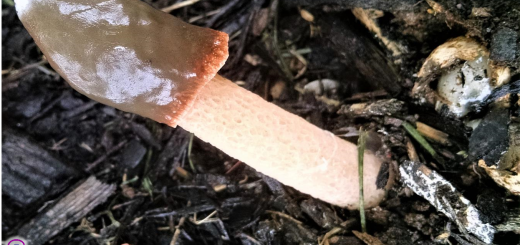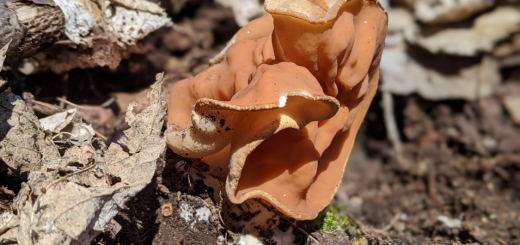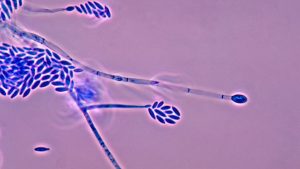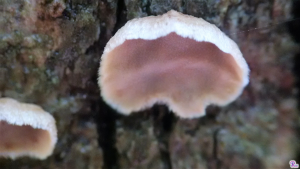#142: Pluteus cervinus, the Deer Mushroom [Archived]
Note: This is an archived post. You can read the current version here.
Pluteus cervinus is one of the first gilled mushrooms to appear in the spring, although you can also find it during summer and fall. Commonly called the “Deer Mushroom,” it is distinguished by its free gills, pinkish spore print, radish-like odor, and unique, pointed cystidia (if you have a microscope). In Europe, the mushroom is called the “Deer Shield” (I think mushrooms in the genus Pluteus are called “shields” in Europe, though I’m not sure why) or the “Fawn Pluteus.” I was introduced to this mushroom as the “Fawn Mushroom,” which is not as common as “Deer Mushroom” in the United States.
On the surface, the Deer Mushroom is not very interesting. It is medium-sized to large mushroom with a light brown pileus, white to pink gills, and a white stipe. If not for its size, it would probably go largely unnoticed. P. cervinus grows 4.5-13cm (2-5in) across and 5-13cm (2-5in) tall.
Its cap is smooth and is usually some shade of light brown, though field guides often prefer to describe the color as “fawn.” The color is rather variable and can be nearly white to dark brown, sometimes with tones of grey or olive. Deer Mushrooms tend to have darker colors towards the center of the pileus. You can sometimes find tiny scales or fibers near the center of the otherwise smooth cap. Specimens often feature streaks of darker brown that radiate out from the cap’s center. The pileus starts out convex and opens up to be nearly flat with a large, raised area (called an “umbo”) over the center of the pileus.
The underside of the cap features white to pink gills that radiate out from a central stipe. The gills start out white but become pink to orangish-pink as the spores mature. A key feature for identification is that the gills are free from the stipe. The gills approach the stipe but stop just short of where the stipe meets the pileus.
The stipe of P. cervinus is white, about 1cm thick, and usually features brownish streaks. It is mostly cylindrical in shape, but may expand somewhat at the base. The stipe is smooth and white, except for the small, brown streaks or fibers that are more commonly found in older specimens or towards the bottom of the stipe.
P. cervinus has white, soft flesh that does not bruise when damaged. Its odor and taste are rather mild and reminiscent of radishes. The last time I found this mushroom, it acquired a very pleasant, rose-like odor upon drying. No field guides mention this feature, so my experience could have been a random fluke (I also found a lot of tiny crystals under the microscope that were likely also produced during the drying process).
The spore print is some version of pink: it can be anywhere from pale pink to salmon-pink to brownish-pink. Thanks to the pink spore print and free gills, this mushroom is immediately recognizable as a member of the family Pluteaceae. P. cervinus belongs to the phylum Basidiomycota, class Agaricomycetes, order Agaricales, and family Pluteaceae.
The most striking feature of the Deer Mushroom, its uniquely-shaped cystidia, can be viewed only with the aid of a microscope. Cystidia are large cells that project from various mushroom surfaces and that do not produce spores. The cystidia on P. cervinus are found on the gill surfaces and edges (which technically makes them pleurocystidia and cheilocystidia, respectively). These cystidia are much taller than the surrounding, spore-producing cells (called “basidia”) and so are easily visible under the microscope. Many mushrooms have cystidia, but what sets P. cervinus apart is that its bowling pin-shaped cystidia are topped with multiple, short points. These beautiful, antler-like structures resulted in both the common name “Deer Mushroom” and the species name cervinus (“cervin-” refers to deer).
P. cervinus can be found in temperate forests of North America and Europe, where it grows from well-rotted logs, sometimes appearing terrestrial if the wood is buried. In North America, it is found east of the Rocky Mountains and south of 45°N (roughly the lower ¾ of the United States) but there is also a small population around San Francisco. The mushrooms start appearing during morel season and continue to fruit through the fall. They are most noticeable early in the year, when other large, gilled mushrooms have not yet ventured out.
The Deer Mushroom described in field guides actually represents a few cryptic species in North America. P. rangifer tends to have a darker pileus, usually features more scales/fibers, and is found in boreal forests, which are found well above 45°N. Most West Coast specimens represent P. exilis, which is also darker and scalier. P. petastus usually has a lighter pileus, is often found fruiting in mulch (P. cervinus rarely fruits from mulch), and features numerous “intermediate cystidia,” which are spindle-shaped and do not yet have the characteristic “antler” points. You should be able to key out other Pluteus species using a field guide.
There are a few other pink-spored fungi that could be confused with P. cervinus. Volvariella species also grow on wood but – as the genus name suggests – each has a sac-like membrane called a “volva” or surrounding the base of its stipe. Entoloma species have attached gills and grow on the ground, often close to decomposing wood. Many Entolomas are poisonous, so make sure any Deer Mushrooms you collect have truly free gills and are growing directly from wood. If you take the time to do a spore print, you won’t have to worry about other possible look-alikes.
Although P. cervinus and its cryptic relatives are edible, they are not particularly interesting mushrooms to eat. The taste is bland but slightly radish-like and there are scattered reports of the mushroom causing gastrointestinal upset. P. cervinus spoils very quickly in warm weather, so it should be refrigerated as soon as possible after being picked. Insects enjoy eating these mushrooms and older specimens are often quite buggy. Therefore, only young and fresh mushrooms should be picked. The Deer Mushroom is usually cooked in stews to preserve the radish-like aroma.
See Further:
http://botit.botany.wisc.edu/toms_fungi/june98.html
http://www.mushroomexpert.com/pluteus_cervinus.html
http://www.messiah.edu/oakes/fungi_on_wood/gilled%20fungi/species%20pages/Pluteus%20cervinus.htm
http://www.first-nature.com/fungi/pluteus-cervinus.php
http://www.mykoweb.com/CAF/species/Pluteus_cervinus.html
http://www.rogersmushrooms.com/gallery/DisplayBlock~bid~6657.asp
Miller & Miller, North American Mushrooms: A Field Guide to Edible and Inedible Fungi


![#019: Apiosporina morbosa, Black Knot of Cherry [Archived]](https://www.fungusfactfriday.com/wp-content/themes/hueman/assets/front/img/thumb-medium-empty.png)






![#011: Characteristics of Kingdom Fungi [Archived]](https://www.fungusfactfriday.com/wp-content/themes/hueman/assets/front/img/thumb-small-empty.png)



1 Response
[…] that some species as they appear in field guides – such as P. cervinus, the Fawn Mushroom (FFF#142) – are actually species groups that contain cryptic species. There are no (or very few) features […]